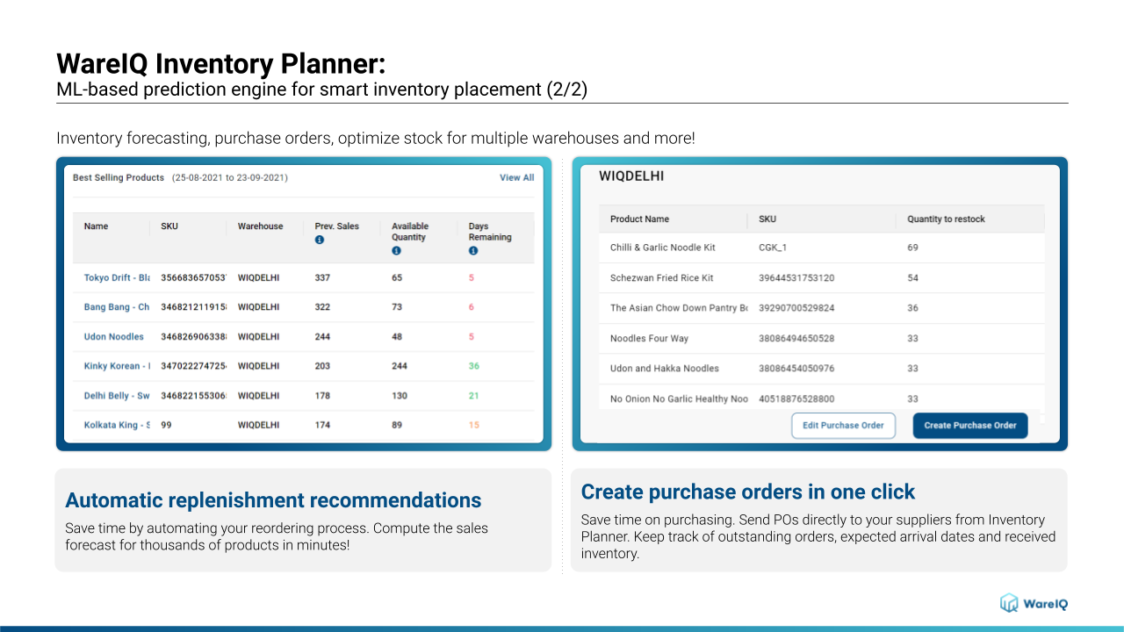Warehouse Capacity: Definition, Calculation, Importance and 10 Tips to Maximise Warehouse Storage Capacity in 2025

In the eCommerce industry, the biggest assets of an online company are its warehouses, dark stores, fulfillment centers, cold stores or whatever else is used for storing their products. As we know, a virtual marketplace does not require a physical store but it does require a place to store listed items. Every eCommerce seller has a warehouse according to the size and scale of their products and needs to abide by specific requirements such as temperature, size, proximity to transport hubs, etc.
The main aspect to be concerned about in a warehouse is the amount of space it has to store products. Needs may be different for each seller but the way to ensure that there is enough space to not only manage inventory or store goods but also track products to prevent stockouts, expiration, tackle high demand , etc. In this article, we will go into detail about what warehouse capacity is, how to calculate it and tips to improve warehouse storage capacity.
- What is Warehouse Capacity?
- How to Calculate Warehouse Storage Capacity?
- Importance of Warehouse Capacity for eCommerce Businesses
- 10 Tips to Increase Warehouse Capacity to Maximise Storage in 2025
- Conclusion: Maximize Your Warehouse Storage Capacity with WareIQ
- Warehouse Capacity Frequently Asked Questions: FAQs
What is Warehouse Capacity?
Warehouse capacity refers to the amount of available space for product storage. Warehouse capacity can assist in understanding the difference between theoretical working capacity and storage capacity. For eCommerce sellers, space is conceivably the most important resource in warehouses and other storage facilities. Businesses can considerably improve the number of products they can keep in the facility by optimizing the utilization of their warehouse space. They can save money on transportation and other expenditures by having more items in storage at once.
Additionally, it gives the warehouse KPI’s personnel easier access to the goods, enabling them to process orders more quickly and deliver the goods to the consumer sooner. Warehouse managers and business owners should take the time to analyze how much space they have and how well they’re utilizing it because space can be scarce in a warehouse setting.
WareIQ, an eCommerce fulfillment company, empowers online brands with a superior-tech platform to compete with Amazon like service levels by bringing their average delivery timelines from 5-10 days to 1-2 days.
How to Calculate Warehouse Storage Capacity?
The first step in figuring out how to improve your warehouse capacity is to understand its present capacity. Here is a quick tutorial on how to determine a warehouse’s capacity expressed in feet:
- Determine how many square feet your entire warehouse complex is. In this instance, let’s assume it is 10,000 square feet.
- Calculate how much space is being used overall for non-storage uses, including offices, restrooms, break rooms, loading zones, etc. Let’s assume that this equals 2,000 square feet.
- To calculate the usable space in your warehouse, subtract the total square feet of non-storage space from the total square feet of your warehouse. The equation is as follows:
Usable Space = Total Square Feet – Non-Storage Space Square Feet
- Next, figure out how much useful storage space you have, i.e., the maximum stack height or clear height. You must take into account the lowest-hanging overhead object for this, such as lighting fixtures or warehouse racks. Let’s assume that this height is 30 feet.
- To calculate your storage capacity in cubic feet, multiply your maximum stack height by the entire amount of usable space:
Maximum Height of Stack in Feet x Usable Space in Square Feet
This might offer you a general idea of how to calculate the storage capacity of your warehouse, but keep in mind that you also need to take into account facility-specific elements, such as workspaces for packing and picking. You can optimize space depending on your company’s warehousing demands, including the number of units and distinctive SKUs, total equipment and fulfillment space needed to operate a warehouse by knowing how to assess warehouse capacity.
Importance of Warehouse Capacity for eCommerce Businesses
Mitigates Miscalculations
Logistics operations depend heavily on warehouse capacity, which extends beyond just optimizing for inventory storage. Determining how much inventory you can afford to keep on hand to meet demand while also lowering the risk of potential stockouts and backorders requires an understanding of your warehouse capacity.
Reduces Storage Costs
Having greater warehousing capacity is not necessarily preferable. Your warehousing and carrying costs, such as rent, storage, picking and packing, and inventory management chores, will go up as your warehouse’s capacity and square footage increase. Understanding your warehouse’s storage capacity will help you determine how much space you need so that you can remove any excess or unwanted procedures.
Speeds Up Order Fulfillment
More room also makes it simple to keep more goods than is required, which can result in an accumulation of dead stock. It is from investing in more inventory upfront, where capital is restricted until it is sold. You can also use the room for order fulfillment in addition to storage. If so, you must select how to organize your warehouse for effective workflows that will allow for quick order fulfillment and improved order accuracy.
10 Tips to Increase Warehouse Capacity to Maximise Storage in 2025
There are different ways to concentrate on your warehouse capacity optimization if you are dissatisfied with the amount of available storage space you are using. You can improve your warehouse utilization rates and save time and money by making a few minor adjustments to the design and organization of your space. Here are 10 suggestions you can employ to make the most of the available space and increase the storage capacity of your warehouse:
Use Storage Solutions
Your warehouse’s storage utilization will be directly impacted by the types of storage solutions you deploy there. Select solutions that are appropriate for your space’s size, shape and products you are storing in order to achieve maximum storage capacity. For better utilization of your space, you can:
- Vertically extend your racks
- Erect a mezzanine over the floor-level shelves
- Reduce aisle width in the racking area
- Modify storing methods
- Add spaces for storing half-pallets
- Utilize your warehouse management system to facilitate directed storage
- Utilize unused space
Rearrange Aisles and Racks
After selecting the best pallets, boxes and racks, it’s time to organize how you store them to maximize your storage capacity. For the best fit and organization, group storage units and objects of the same size should be stored together. As long as they are still wide enough for your personnel and machinery to pass through safely and effectively, you can make your aisles a little bit narrower to put a few more rows in. Your storage capacity, cube size and total usage will all rise with a well-organized warehouse. It will also make your employees more productive because they will be able to move around and find things more easily.
Increase Height Clearances
The existing warehouse storage capacity you have is significantly impacted by the clear height of your building. Even though it could seem challenging to get more vertical space, you can improve your clear height by paying attention to any machinery, infrastructure or other objects that are suspended from the ceiling. You might be able to move, replace or adjust hanging lights, security systems, cameras or other objects to clear a few extra feet of space. To increase your clear height and thus, your possible storage space, consider mounting lights and security systems to the roof or walls rather than the ceiling.
Keep Track of Seasonal Inventory
Make sure to account for any volatility throughout the off-seasons if your warehouse stocks a lot of seasonal goods, such as holiday decorations, beach gear and winter clothing. Aiming for both an appropriate storage utilization number for the off-season and an optimal storage utilization number for the peak season are ideal strategies for warehouses that handle a considerable amount of seasonal inventory. It just would not make sense for them to maintain the same stock levels in the warehouse throughout the year, nor would it make sense to reorganize the space twice a year to accommodate the variations in inventory.
Always Keep Some Extra Space
In order to accommodate expansion and the introduction of new products, your warehouse’s total storage cube should not be more than one-fourth of the total. If your warehouse capacity is operating at its full extent, it is an indication that it’s time to expand your warehouse. You should always leave room in your warehouse for sale or growth since you never know when one of your products may become instantly popular. If that occurs, you will need to start stocking up on that specific item right away to meet demand. Before you face such an issue, being equipped to deal with it is a better alternative.
Group Storage Locations
Many retailers have different fulfillment centers and warehouses to store the same or similar products. To create more usable space, you can opt to store them in the same location so that it will be more organized and readily accessible if they are required urgently. This also creates more storage space across fulfillment centers so that more products can be stored.
Store Excess Inventory in Off-Site Locations
Some high-demand or seasonal products need to be ordered in large quantities to prevent stockouts and increased delivery times. However, these units might prevent other goods that also have decent demand levels from being stored in less-convenient locations. By storing excess inventory in off-site locations, warehouse storage capacity increases for more relevant items.
Consider Using Dropshipping
If your storage facilities and warehouse capacity are overburdened, consider making use of dropshipping so that products can be manufactured and shipped by the vendor directly and never have to be stored by you which creates more space for your other products while also maintaining inventory levels of other products directly through the vendor.
Arrange Inventory Based on Demand
Different products have varying levels of demand and this is based on a variety of factors such as season, relevance, price, age and more. It is important to store high-demand items in the most easily accessible way possible to ensure that they get picked and packaged swiftly while storing lower-demand items in less accessible locations.
Calculate Your Storage Dimensions
You should guess when it comes to your warehouse storage capacity. Do not just have a simple look to estimate how much space you are utilizing for storage capacity. Take the time to calculate and determine the logistics of your total space so that you are aware of how to arrive at an exact number for your warehouse’s storage capacity and utilization. Knowing proper figures can help you create the most effective layout for your warehouse.
Conclusion: Maximize Your Warehouse Storage Capacity with WareIQ
Increasing warehouse storage capacity is of utmost importance to eCommerce sellers, especially for ones that have already started expanding their operations. There are many different ways to optimise your warehouse capacity but one of the quickest and most effective options is to partner with a 3PL fulfillment company. Do you require access to more storage space? If yes, you can entrust WareIQ to handle all of your decentralized fulfillment center locations along with their management requirements.

At WareIQ, you not only get access to our nationwide network of fulfillment centers and dark stores but we also work with you to decide how to distribute it most effectively across our logistics network based on product demand and proximity to your customers. By shipping orders to various locations, you can increase the number of customers you serve while lowering shipping costs and shortening transit times.
eCommerce sellers are given complete visibility and transparency into their fulfillment operations with our sophisticated, user-friendly interface. You can have insights into factors such as warehousing costs, historical data, inventory management and real-time inventory updates. We also offer an entire range of other eCommerce services such as order fulfillment and online marketplace integration through our custom WMS.








